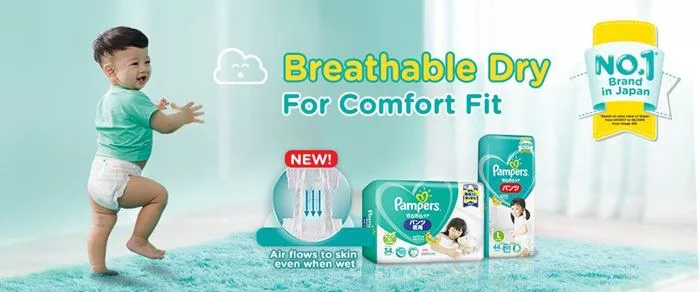Setting up a comfortable and safe environment for diaper changing is crucial for both you and your baby. Follow these steps:
Prepare the Changing Area
Choose a Suitable Surface: Select a flat, sturdy surface such as a changing table, diaper changing pad, or a clean towel on the floor.
Gather Supplies: Have all necessary items within reach, including a clean Pampers diaper, baby wipes, diaper rash cream (if needed), and a change of clothes.
Lay the Baby Down
Positioning your baby properly ensures a smooth and safe diaper change:
Gentle Placement: Lay your baby down gently on their back, ensuring they are comfortable and secure.
Use a Changing Pad: If available, use a changing pad or mat to provide a soft and cushioned surface for your baby.
See also: Are Pampers Pure Diapers Safe?
Remove the Old Diaper
Taking off the old diaper without making a mess is essential for a hassle-free diaper change:
Undo Tabs: Carefully undo the tabs on the dirty diaper, ensuring not to disturb your baby too much.
Fold Down Front: Fold the front half of the diaper down and away from your baby, but keep it under them to catch any surprises.
Clean the Baby
Proper cleaning helps prevent irritation and keeps your baby’s skin healthy:
Use Baby Wipes: Gently clean your baby’s diaper area using baby wipes. Wipe from front to back for girls to prevent infections.
Addressing Redness: If your baby has any redness or irritation, apply a thin layer of diaper rash cream to soothe and protect their skin.
Prepare the New Diaper
Setting up the new diaper ensures a quick and efficient change:
Unfold the Diaper: Open a clean Pampers diaper and unfold it, checking the leg cuffs to ensure they are unfolded to prevent leaks.
Position Underneath: Slide the back half of the diaper under your baby, ensuring the waistband is positioned below their belly button.
Bring the Front Half Up
Securing the diaper properly ensures comfort and leak protection:
Position Correctly: Bring the front half of the diaper up between your baby’s legs, ensuring it is centered and snug.
Secure Tabs: Fasten the tabs evenly to the front of the diaper, adjusting for a comfortable fit around the waist and legs.
Adjust for Comfort
Ensuring the diaper fits well prevents leaks and discomfort:
Check Leg Cuffs: Ensure the leg cuffs are gently wrapped around your baby’s thighs to prevent leaks.
Comfortable Fit: The diaper should fit snugly around the waist and legs without being too tight or restrictive.
Dispose of the Old Diaper
Proper disposal helps maintain cleanliness and hygiene:
Securely Roll Up: Roll up the used diaper and secure the tabs to contain any mess.
Dispose Properly: Place the used diaper in a diaper pail with a secure lid or seal it in a disposal bag for later disposal.
Dress the Baby
Completing the change with fresh clothes ensures your baby’s comfort:
Replace Clothes: Dress your baby in clean clothes if the previous ones were soiled during the diaper change.
Wash Hands
Maintain cleanliness and hygiene post-diaper change:
Hand Hygiene: Thoroughly wash your hands with soap and water after each diaper change to prevent the spread of germs.
Tips for Successful Diaper Changing
Following these tips helps streamline diaper changes and keeps your baby comfortable and happy:
Change Regularly:
Change diapers every 2-3 hours or as soon as they become wet or soiled to prevent diaper rash.
Check Fit:
Regularly check your baby’s diaper fit as they grow to ensure they are in the correct diaper size.
Be Prepared:
Keep a well-stocked diaper bag ready for outings with extra diapers, wipes, and a changing pad.
Comfort First:
Ensure your baby is comfortable and secure during diaper changes to minimize fussiness.
Conclusion
By following these step-by-step instructions and tips, you can confidently change your baby’s diaper using Pampers diapers, ensuring your little one stays dry, comfortable, and happy throughout the day.
FAQs
How Should a Pampers Diaper Fit?
A Pampers diaper should fit comfortably and snugly:
Waist: The waistband should sit just below your baby’s belly button, not too tight to leave marks, but secure enough to prevent leaks.
Legs: The leg cuffs should be gently wrapped around your baby’s thighs to prevent leaks without causing discomfort.
Which Is the Front Side of Pampers Pants?
The front side of Pampers pants typically features colorful designs, logos, or labels indicating the front. Ensure these markings are positioned at the front before putting the diaper on your baby.
What Is the Safest Way to Change a Baby’s Diaper?
To change a baby’s diaper safely:
Secure Surface: Use a stable, flat surface like a changing table or mat.
Supervise: Keep one hand on your baby at all times to prevent them from rolling off the changing surface.
Stay Prepared: Have all necessary supplies within reach to avoid leaving your baby unattended.
Do I Need to Wipe My Baby After Pee?
It’s generally recommended to wipe your baby’s genital area with a baby wipe after they pee:
Girls: Wipe from front to back to prevent spreading bacteria from the anus to the urinary tract.
Boys: Gently wipe around the genitals and folds of the skin to keep the area clean.
Following these steps and guidelines ensures a safe and comfortable diaper change experience for both you and your baby.


